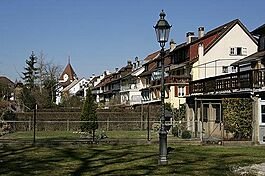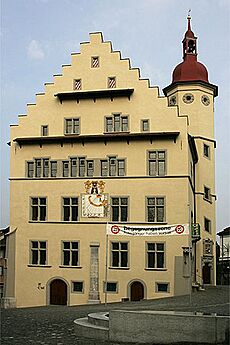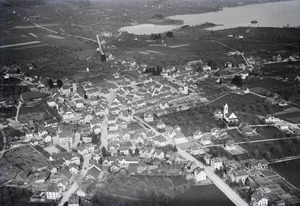Sursee facts for kids
Quick facts for kids
Sursee
|
||
|---|---|---|
 |
||
|
||
| Country | Switzerland | |
| Canton | Lucerne | |
| District | Sursee | |
| Area | ||
| • Total | 5.83 km2 (2.25 sq mi) | |
| Elevation | 504 m (1,654 ft) | |
| Population
(Dec 2020 )
|
||
| • Total | 10,361 | |
| • Density | 1,777.2/km2 (4,603/sq mi) | |
| Postal code |
6210
|
|
| Surrounded by | Geuensee, Knutwil, Mauensee, Oberkirch, Schenkon | |
| Twin towns | Highland (United States), Martigny (Switzerland) | |
Sursee is a town in Switzerland, located in the canton of Lucerne. It sits at the northern end of Lake Sempach. The town's name comes from the Sure stream, which flows out of the lake (See means lake in German). Sursee is part of the Sursee district.
Contents
History of Sursee
Ancient Times and Early Settlements
People have lived around Lake Sempach for a very long time. Evidence shows settlements since the Neolithic period, also known as the New Stone Age.
Sursee is home to an ancient village called Halbinsel. It's a pile-dwelling settlement, meaning houses were built on stilts over water. This site is so important that it's a UNESCO World Heritage Site. Halbinsel was settled many times during the Stone Age and the Bronze Age.
Archaeologists found different layers of settlements at Halbinsel. At a spot called Zellmoos, the oldest layer is from the Cortaillod culture. Above it are several layers from the Late Bronze Age. Another spot, Gammainseli, also has three Late Bronze Age layers.
These sites were discovered long ago and excavated many times. They found houses with clay floors. Many items like pottery, bronze tools, bones, and stone tools were also found. Divers explored the Gammainseli site and found pottery pieces and bronze items.
During the Roman era, there was a small village (called a vicus) near Sursee. In the 8th century, a wooden church was built, and the town grew around it. This church was later rebuilt with stone around 800 AD and again around 1000 AD.
Becoming a Town
The first time Sursee was mentioned in writing was in 1036. A nobleman named Ulrich I of Lenzburg gave the village to Beromünster abbey. Sursee grew into a small town in the 13th century. It was given official city rights by the Dukes of Austria in 1299.
In 1415, the city of Lucerne took control of Sursee. However, Sursee was allowed to keep its city rights under the new rulers.
Modern Development
In the late 1800s, a furnace factory called Ofenfabrik Sursee became the biggest employer. By the mid-1900s, Sursee started to grow very quickly. This led to problems similar to many growing cities.
However, in the 1990s, local leaders worked to guide this growth. They wanted to make sure new buildings were good quality. They also wanted to protect the town's historic look.
In 2003, Sursee won the Wakker Prize. This award is given for protecting and developing architectural heritage. Sursee won for its efforts to manage growth. They made sure the old town stayed lively, not just a museum.
Geography of Sursee
Sursee covers an area of about 5.9 square kilometers (2.3 square miles). A large part of this land, about 30.7%, is used for farming. Forests cover 21.8% of the area. The largest part, 46.8%, is built-up with buildings and roads. Only a small part, 0.7%, is non-productive land like rivers.
In 1997, about 21.88% of Sursee's land was forested. For farming, 28.72% was used for crops or pastures. Another 2.05% was used for fruit trees or vineyards.
In the settled areas, 17.95% is covered by buildings. Industrial areas make up 9.23%. Parks and green spaces cover 3.76%. Roads and other transport areas are 15.21% of the town.
Population and People
Population Numbers
Sursee has a population of about 10,800 people (as of 2022). About 16.9% of the people living in Sursee are foreign nationals. Over the last ten years, the town's population has grown by about 6.7%.
Languages Spoken
Most people in Sursee speak German. About 86.9% of the population speaks German as their main language. Albanian is the second most common language, spoken by 2.8% of people. Serbo-Croatian is the third most common, also spoken by 2.8%.
Age Groups
The population of Sursee includes people of all ages. About 20.2% of the people are 19 years old or younger. Those aged 20 to 39 make up 31.2% of the population. People aged 40 to 64 are 32.9% of the population. Older adults, aged 65 to 79, are 11.7%. About 3.5% are 80 to 89 years old, and 0.5% are 90 or older.
Education in Sursee
Many adults in Sursee have a good education. About 68.3% of people aged 25 to 64 have finished higher education. This includes either non-mandatory upper secondary education or a university degree.
Homes and Buildings
In 2000, there were 3,288 households in Sursee. About 34.5% of these households had only one person living in them. About 8.1% were large households with five or more members.
Most buildings in Sursee are homes. In 2000, there were 1,063 inhabited buildings. Of these, 788 were only for housing. The other 275 were mixed-use buildings, meaning they had both homes and businesses. Most homes were two or three stories tall.
Work and Jobs
Sursee has a low unemployment rate of 2.37%. Many people work in different sectors. In 2005, about 104 people worked in farming (primary sector). About 1,990 people worked in manufacturing (secondary sector). The largest number, 7,404 people, worked in services like shops and offices (tertiary sector).
In 2000, about 55.5% of the town's population was employed. Women made up 46.4% of the workforce.
Religion
In 2000, most people in Sursee were Roman Catholic, making up 74.5% of the population. Protestants were 9.8%. Other Christian faiths made up 3.34%. There were also people who were Muslim (4.73%) and a small number who were Jewish. About 3.71% of people did not belong to any organized religion.
Sister Cities
Sursee has special connections with two other cities. These are called "sister cities" or "twin towns".
Famous People from Sursee
- Hans Küng (1928–2021), a well-known Swiss Catholic priest and theologian.
- Haris Seferovic (born 1992), a Swiss professional footballer.
- Rolf Ineichen (born 1978), a Swiss racing car driver.
See also
 In Spanish: Sursee para niños
In Spanish: Sursee para niños








